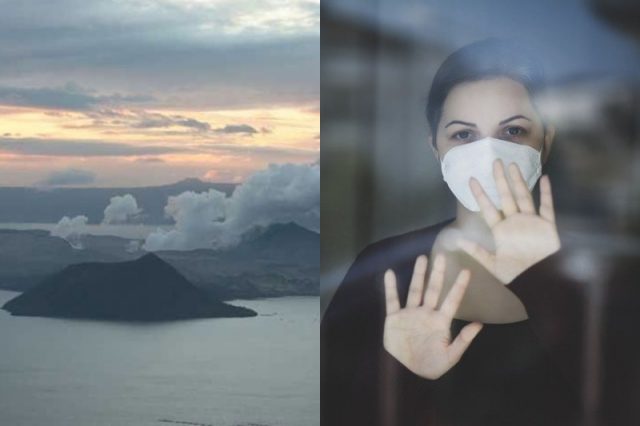
It has been two years since the historic eruption of the Taal Volcano.
The incident was also the beginning of what Filipinos call “the age of face masks” as soon after, the World Health Organization has declared the COVID-19 outbreak as a pandemic.
The keyword “Taal Volcano” landed on local Twitter’s top trends list on Wednesday as Filipinos remember the second anniversary of the volcano’s eruption.

“I remembered buying a ton of face masks in Jan. 2020 to prep for my trip to Manila due to Taal Volcano ash fall… never thought it would stick this long for a different reason. #theageoffacemasks,” a Twitter user said.
“2 years since we started wearing face masks, and it all started with Taal Volcano’s eruption,” another online user recalled with a concerned face emoji.
“Tandang-tanda ko pa iyang Taal Volcano incident. Naiirita akong magsuot ng face mask. ‘Di ko alam na senyas pala na dalawang taon tayong magsusuot no’n,” a different Filipino said.
Another Twitter user called the Taal Volcano eruption an “opening salvo of the ‘Age of Face Masks.'”
Harbinger of face masks.
A boy is seeing wearing a face mask as a protection from falling volcanic ashes of the erupting Taal Volcano back in 12 Jan 2020.
For us, it is like the Opening Salvo of the “Age of Face Masks.” Never knew that it’ll be part of our daily lives thereon. pic.twitter.com/cbcGmq0j0L
— Berniemack Arellano (@habagatcentral) January 11, 2022
On this day
In January 2020, the Batangas-based volcano woke up from its decades-long slumber since its eruption in the ’70s and severely upended lives, especially those living near the area.
The eruption happened on the afternoon but as early as 8 a.m. of that day, earthquakes have already been felt within the vicinity.
A video of the phreatic explosion from the main crater was recorded in which plumes 100 meters high or around 328 feet was witnessed by some Filipinos. It prompted authorities to raise the volcano’s alert level to Level 2.
At 4 p.m., the alert level was elevated to Level 3. At that time, plumes had reached a kilometer high.
By 7:30 p.m. of that day, Alert Level 4 was raised over Taal Volcano which meant that “hazardous explosive eruption” was possible within hours to days from that time.
Wet ashfall and rock fragments from the massive plumes were reported to have reached as far as Quezon City.
The volcano was just on Alert Level 1 at the start of the day.
ALSO READ: A volcano warning? Declaration of Alert Level 4 of GCQ in NCR ensues confusion, ‘panic’
By the end of January 12, thousands of locals within the 14-kilometer radius of the volcano were ordered to evacuate to safer locations. Others lost their lives due to anxiety and failure to follow the evacuation orders.
The Department of Health had advised the public to stay indoors, close all windows and doors and to use dust masks to avoid exposure from the ashfall which can cause respiratory problems.
It, later on, advised residents near Taal Volcano and in areas where volcanic ashes are thick to wear N95 masks, a respiratory protective device that filters at least 95% of airborne particles.
Those in farther areas like Metro Manila, however, were only advised to wear a surgical or cloth mask or a bandana covering.
ALSO READ: Throwback Tuesday: Filipinos recall how Taal Volcano’s historic eruption affected them a year ago
‘Age of face masks’
On a global scale, the WHO on the same month declared the coronavirus disease outbreak as a public health emergency of international concern.
That came after reports of people in Wuhan, China experiencing pneumonia with an unknown cause surfaced on December 2019.
RELATED: This day last year, WHO declared COVID-19 outbreak a pandemic. Here’s how Filipinos remember it
In March 2020, two months after Taal Volcano’s eruption, the health agency officially declared the COVID-19 outbreak a pandemic.
A month after, the Philippine government made face masks mandatory for Filipinos as preventive measures against the virus, particularly those in areas under enhanced community quarantine.
Any face covering such as indigenous, reusable or do-it-yourself masks, face shields, or handkerchiefs, was still accepted at that time.
Nowadays, experts are advising the public to switch their cloth masks to surgical masks or those that fit the face without gaps such as KN95 or KF94 amid the threat of the highly transmissible Omicron variant.
These masks have certain filters that can prevent tiny particles from getting into one’s nose or mouth, the key areas where the virus can enter via airborne or respiratory transmission.
Researchers led by a Texas A&M University professor believe that wearing a face mask in public “corresponds to the most effective means to prevent inter-human transmission.”
“Our study establishes very clearly that using a face mask is not only useful to prevent infected coughing droplets from reaching uninfected persons, but is also crucial for these uninfected persons to avoid breathing the minute atmospheric particles (aerosols) that infected people emit when talking and that can remain in the atmosphere tens of minutes and can travel tens of feet,” Mario Molina said, as quoted by Science Daily.









